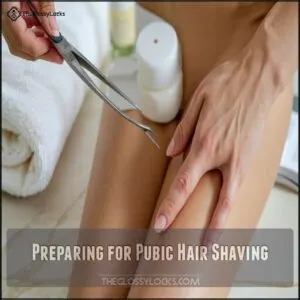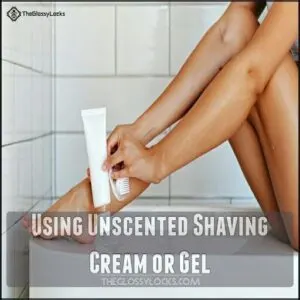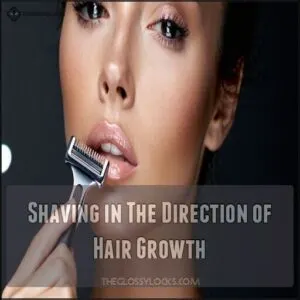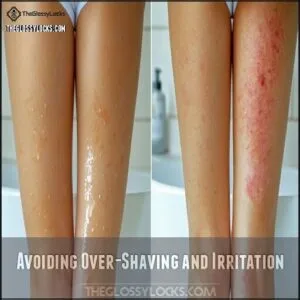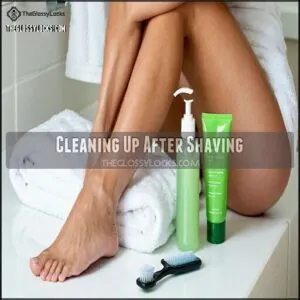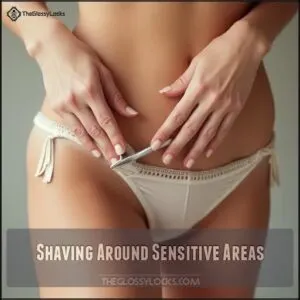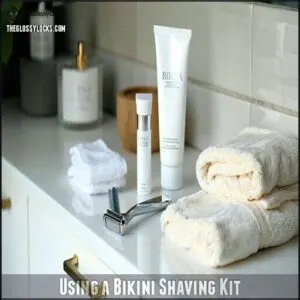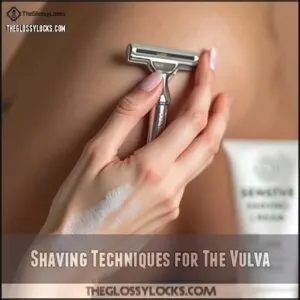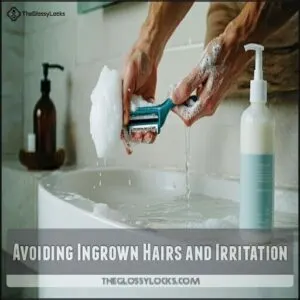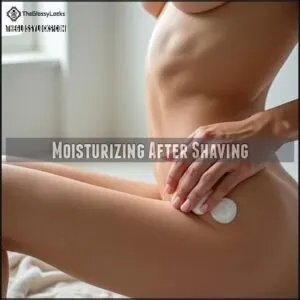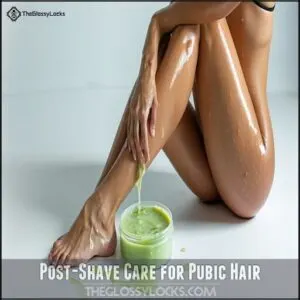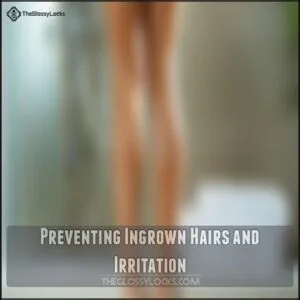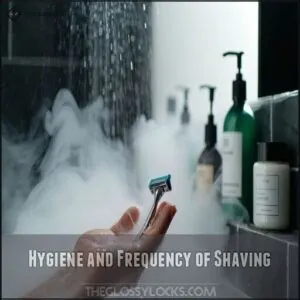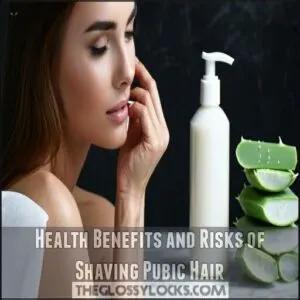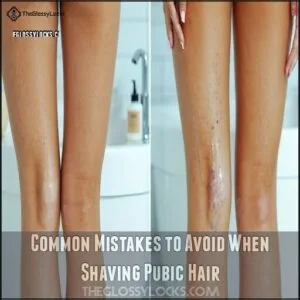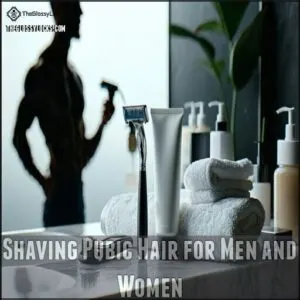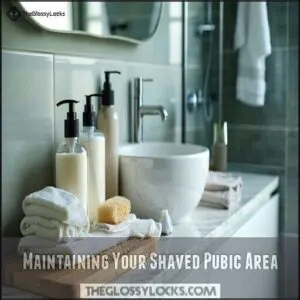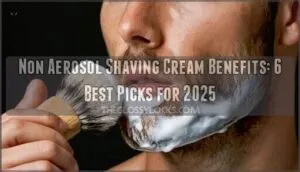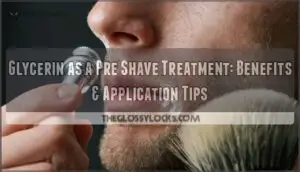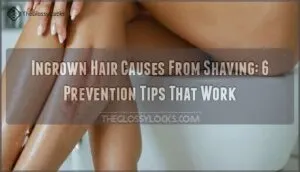This site is supported by our readers. We may earn a commission, at no cost to you, if you purchase through links.
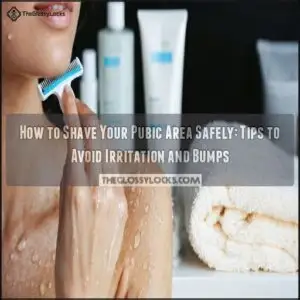 To safely shave your pubic area, start by trimming longer hairs with scissors.
To safely shave your pubic area, start by trimming longer hairs with scissors.
Softening the area with warm water for 5-10 minutes, then applying unscented shaving cream, is essential for a smooth shave.
Use a clean, sharp razor and shave in the direction of hair growth using gentle, short strokes. Don’t press too hard—let the razor do the work.
Rinse with cool water afterward and apply alcohol-free moisturizer to prevent irritation.
Change your razor frequently and avoid sharing it with others.
While it seems straightforward, the right technique makes all the difference between a smooth result and an uncomfortable week of recovery.
Table Of Contents
- Key Takeaways
- Preparing for Pubic Hair Shaving
- How to Shave Your Pubic Area Safely
- Shaving Techniques for Pubic Hair
- Post-Shave Care for Pubic Hair
- Preventing Ingrown Hairs and Irritation
- Hygiene and Frequency of Shaving
- Health Benefits and Risks of Shaving Pubic Hair
- Common Mistakes to Avoid When Shaving Pubic Hair
- Shaving Pubic Hair for Men and Women
- Maintaining Your Shaved Pubic Area
- Frequently Asked Questions (FAQs)
- How do you shave a man’s pubic hair?
- What are the ways to prevent pediculosis pubic?
- Why should you prepare your pubic area for a shave?
- What should you do before shaving your pubes?
- What should I use to protect my skin while shaving pubic hair?
- How can I reduce skin irritation after shaving my pubic area?
- Are there any health benefits to shaving your pubic hair?
- What are some pubic hair styles for guys?
- Is it normal for a man to shave his pubic hair?
- What is the best way to shave your pubic area?
- Conclusion
Key Takeaways
- Trim long hair first to about 1/4 inch to avoid razor clogging and make shaving easier.
- Use warm water to soften the hair and apply unscented shaving cream or gel for a smooth shave.
- Always shave in the direction of hair growth using light pressure and gentle strokes to prevent irritation and ingrown hairs.
- Moisturize your skin with an alcohol-free lotion after shaving to soothe and hydrate the area.
Preparing for Pubic Hair Shaving
Before shaving, you need to take steps to prepare your pubic area to prevent irritation and cuts.
This includes trimming the hair, softening the skin, and exfoliating to create the best conditions for a safe and smooth shave.
Trimming and Shortening Pubic Hair
Trimming pubic hair is like clearing a path before a hike—it makes everything smoother. Start by shortening the hair to about 1/4 inch. This reduces razor clogging and skin irritation while keeping things hygienic. Always trim dry hair for better control and less risk of snags.
Trim first, shave second—just like clearing brush before a hike makes the trail smoother, trimming before shaving creates the perfect path for your razor.
Use purpose-made trimming tools like safety scissors or pubic grooming trimmers, and don’t rush the process. Pull the skin taut to avoid accidental nicks, and trim in the direction of hair growth for comfort.
Here are a few tips to make trimming easier:
- Create a safe workspace, like a clean bathroom floor.
- Use a fine-toothed comb to guide the trimming process.
- Choose clippers with guard settings to control hair length.
- Trim regularly—consistent grooming prevents discomfort later.
Consider pre-shave exfoliation techniques to further minimize the risk of ingrown hairs.
Allowing Time to Get Used to The Feeling
Your skin deserves a sensory adjustment period to get used to bare skin comfort after pubic hair removal.
It’s normal to feel some initial sensitivity, like mild itchiness. Gradual hair removal eases this phase while reducing irritation risks.
Embrace loose clothing and gentle moisturizers during this phase to help your skin breathe.
Patience is essential; let your body adapt naturally. By following intimate shaving tips, you’ll manage discomfort and prepare for smoother, irritation-free shaving of your pubic area every time, ensuring irritation-free results.
Choosing The Right Razor
Picking the right razor is vital for a smooth, irritation-free shave. A sharp razor minimizes nicks and tugging, especially if you have sensitive skin.
Consider the blade count—more blades mean smoother strokes with fewer passes. An ergonomic handle helps you navigate tricky angles without slipping, making the process safer.
Moisturizing strips are a game-changer, soothing your skin as you shave. For extra safety, try electric razors with protective guards. Disposable razors work well too, but make certain the razor blade is sharp to avoid irritation.
Don’t forget maintenance—clean blades after use to prevent corrosion and replace dull ones frequently. Many people find relief using products designed for razor sensitive skin.
- **Look for stainless steel blades that resist corrosion.
- **Choose razors designed for sensitive skin.
- **Use moisturizing strips for added comfort.
- **Opt for an ergonomic handle for better control.
Softening The Hair With Warm Water
A good shave starts with softening the pubic hair, and warm water is your best friend for this.
It’s more than just comfort—it’s about preparing your skin and hair for the razor. Warm water benefits include opening pores, relaxing hair follicles, and boosting hydration, making hair easier to cut and less likely to tug.
Here’s how to do it right:
- Optimal Soak Time: Spend 5–10 minutes in a warm bath or shower to fully hydrate hair and skin.
- Water Temperature Effects: Use pleasantly warm water—too hot strips natural oils and dries out skin.
- Hydration Importance: Confirm your hair feels soft before proceeding.
Taking a few extra minutes guarantees shaving preparation is thorough and sets the stage for a smoother, irritation-free experience.
Exfoliating Before and After Shaving
Before shaving, exfoliate to prep your skin for a smoother, more comfortable experience. Scrub gently using a loofah or an exfoliating sponge—this clears away dead skin, boosts razor glide, and reduces razor burn and irritation.
Use mild shaving scrubs to help with ingrown hair prevention. After shaving, exfoliate again using a soft scrub to keep the area clean and irritation-free.
Incorporate weekly treatments like AHA or BHA exfoliants into your routine for long-term skin renewal. Consistency matters—don’t overdo it, as too-frequent scrubbing can irritate sensitive areas.
With regular exfoliation, you’ll enjoy noticeable softness and healthier post-shave skin care results.
How to Shave Your Pubic Area Safely
When shaving your pubic area, it’s important to take steps that protect your skin from irritation and bumps.
Using proper tools and techniques guarantees a safer and smoother result without unnecessary discomfort.
Using Unscented Shaving Cream or Gel
A smooth shave starts with choosing the right product, especially for the delicate task of shaving your pubic area. Always go for unscented alternatives to protect against allergic reactions and irritation caused by harsh fragrances. Choose a shaving cream or gel specifically for sensitive skin, and look for hydrating ingredients to keep discomfort at bay.
Apply a generous layer of cream or gel before shaving, letting it sit a minute to soften the hair for a smoother glide. This reduces tugging and also helps prevent bumps and redness. Consider purchasing quality products for the best results.
The prep might seem small, but the difference it makes is anything but.
- Prevent cuts and irritation with quality lather.
- Protect sensitive skin types from harsh chemicals.
- Improve your shaving experience with proper application.
- Avoid bumps and itchiness from poor blade movement.
Shaving in The Direction of Hair Growth
When shaving the pubic area, always go with the hair’s natural direction. This approach minimizes irritation, prevents razor burn, and substantially reduces the risk of ingrown hairs. Think of it as guiding the razor to follow the path your hair naturally grows—your skin will thank you.
To shave safely, keep light, steady pressure on the razor and stretch the skin taut where possible. This creates a smoother surface for your blade to glide over perfectly. Avoid rushing, as slower strokes protect your skin from nicks.
- Pro Tip: Always clean the razor after every few strokes to keep it unclogged and sharp for better results.
Remember, gentleness and patience are key to comfortable pubic area care.
Avoiding Over-Shaving and Irritation
Over-shaving can wreak havoc on your skin, especially in sensitive areas.
It’s tempting to keep shaving until every hair is gone, but overdoing it can lead to razor burn, skin irritation, and frustrating bumps. Give your skin breathing room between sessions to heal and stay smooth. Always use a sharp blade—dull razors tug at hair and worsen irritation.
Considering pre-shave exfoliation can further minimize the risk of ingrown hairs.
Stick to these tips for irritation-free results:
- Shaving frequency matters: Don’t shave daily; wait until hair regrows to a comfortable length.
- Lubrication importance: A quality shaving gel reduces friction and protects sensitive skin.
- Gentle pressure works best: Let the razor glide—pressing too hard invites razor burn.
These simple shaving techniques for sensitive areas can save your skin.
Cleaning Up After Shaving
Once you’re done shaving, rinse thoroughly with warm water to wash away cream, stray hairs, and debris.
Pat dry with a soft towel—don’t rub, as it can irritate your skin.
Apply a soothing lotion like aloe vera or an alcohol-free aftershave pubic area product to calm and hydrate. Moisturize skin to lock in softness.
For nicks or cuts, treat them gently and apply a healing balm. Anti-chafe products add comfort post-care.
Shaving Around Sensitive Areas
When shaving sensitive areas like the labia, bum, or scrotum, keep the skin tight (Skin Tension) to prevent nicks.
Use gentle Razor Pressure while following hair growth, and rely on a sharp blade (Blade Sharpness) for a smooth shave.
Adjust your razor’s angle (Contour Shaving) to fit curves.
Rinse the blade regularly to avoid clogging and irritation.
Sensitive skin shaving is safer with shaving cream, ensuring comfort while mastering how to shave down there effectively with sharp blade and proper Skin Tension.
Shaving Techniques for Pubic Hair
To shave your pubic area effectively, you’ll need the right tools, proper technique, and a little patience.
By following careful steps, you can avoid common issues like irritation, cuts, and ingrown hairs, which is crucial for effective shaving.
Using a Bikini Shaving Kit
A bikini shaving kit can simplify bikini line shaving while protecting your skin from irritation. Before diving in, trim your pubic hair—longer strands clog razors and make shaving pubic areas harder. Start with a trimmer designed for the bikini area to make grooming more manageable. Exfoliate gently to remove dead skin and reduce ingrown hairs.
When it’s time to shave, apply a shaving cream made for sensitive skin—Cream Compatibility is key to avoiding irritation. Always use a sharp, clean razor to guarantee smooth results and prevent nicks. You can find a suitable bikini shaving kit online.
Here are some practical tips:
- Kit Components: Choose sets with quality razors and creams formulated for shaving pubic areas.
- Technique Differences: Shave slowly, rinsing the blade often to avoid clogging.
- Razor Quality: Replace dull blades frequently to protect Skin Sensitivity.
With careful prep and the best shaving methods, pubic hair grooming becomes stress-free.
Shaving Techniques for The Vulva
When learning how to shave down there safely, especially in the vulva area, preparation is your best friend. Start by trimming pubic hair to less than 1/4 inch for easier handling and to reduce skin irritation. Wet the area with warm water to soften both skin and hair—this makes all the difference.
Apply a sensitive shaving cream specially designed for the pubic area to protect the skin. This step is crucial for a safe and comfortable shaving experience.
While shaving the mons pubis, follow the grain using light pressure. For areas like the labia, use Vulva Skin Tension by gently pulling skin taut.
Keep strokes short (Safe Stroke Length) and adjust the Razor Glide Angle for better precision. Rinse your blade frequently and verify its Blade Sharpness for clean shaving techniques.
Avoiding Ingrown Hairs and Irritation
Avoiding ingrown hairs and irritation starts with proper exfoliation methods. Gently use a loofah, washcloth, or soft scrub to remove dead skin and free trapped hairs before shaving. Think of it as clearing the way for a smoother shave.
For razor choice, always go for a sharp blade—dull razors are notorious for causing razor burn and irritating your skin. Use shaving cream to create a protective layer and shave in the direction of hair growth.
This helps reduce irritation and prevents pesky bumps. Once done, rinse the area with warm water, pat it dry, and soothe with an alcohol-free balm. These irritation remedies will help keep ingrown hairs and sensitivity at bay.
Moisturizing After Shaving
Moisturizing after shaving is an essential part of protecting your skin and maintaining its health. Start by gently patting the area dry with a clean towel, then apply a fragrance-free lotion or natural oil to lock in moisture and soothe irritation.
Look for skin moisturizers packed with soothing ingredients like aloe vera, chamomile, or vitamin E, which calm redness and reduce discomfort. For best results, moisturize immediately after drying to enhance absorption and prevent dryness.
Avoid scented products to reduce the risk of irritation. Let the product sink fully into your skin before dressing to avoid friction.
- Fragrance-Free: Use unscented lotions or creams.
- Soothing Ingredients: Opt for natural oils or vitamin E.
- Application Timing: Moisturize right after drying.
- Postshave Care: Hydrate consistently for irritation-free results.
Post-Shave Care for Pubic Hair
After shaving, it’s essential to care for your skin to avoid irritation and bumps.
Use gentle moisturizers or soothing products like aloe vera to keep the area calm and hydrated.
Exfoliating After Shaving
Exfoliating after shaving is key to smooth skin and fewer bumps.
Wait three to four days before starting gentle exfoliation with a sugar scrub or sensitive-skin cleanser.
Use light, circular motions to prevent irritation and ingrown hairs. Frequency matters—don’t overdo it, as over-exfoliation can cause redness.
Follow up with moisturizer to lock in hydration and complete your postshave care routine, ensuring you maintain smooth skin.
Applying Egg Oil or Aloe Vera
After shaving, your skin deserves gentle care to stay smooth and irritation-free.
Egg oil and aloe vera offer natural remedies that work wonders for post-shave soothing. Egg oil benefits include reducing redness and preventing ingrown hairs with its omega-3 fatty acids. Aloe vera uses its cooling properties to calm razor burn and hydrate sensitive skin.
- Egg oil: A few drops fight irritation and soften the skin.
- Aloe vera: A dollop locks in moisture while cooling inflamed areas.
Apply a thin layer right after shaving to keep your pubic area feeling refreshed and bump-free.
Using Unscented Moisturizer
Right after shaving your pubic area, keeping your skin hydrated is a game-changer for avoiding irritation and maintaining comfort. Grab a fragrance-free moisturizer specially crafted for sensitive skin and smooth it gently over the shaved area. This locks in hydration, calms potential irritation, and reinforces your skin barrier.
Look for soothing ingredients like aloe vera, chamomile, shea butter, or glycerin. These provide hydration benefits and also deliver irritation relief. It’s best to apply moisturizer after a warm shower—your skin will absorb it better when it’s slightly damp. Instead of rubbing, lightly pat the product on to avoid aggravating sensitive skin.
Here’s how to keep it simple:
| What to Use | Why It Matters | Top Ingredients |
|---|---|---|
| Fragrance-free lotion | Prevents irritation | Aloe vera, shea butter |
| Hydrating oils | Maintains skin barrier | Chamomile, glycerin |
Apply daily to maintain smooth, happy skin.
Applying Powder to Absorb Sweat
After applying moisturizer, use a talc-free powder to keep your pubic area dry and fresh.
Powders designed for personal grooming work best, so skip scented powders or those containing talc, which may cause irritation.
Opt for alternative absorbents like cornstarch-based options or Gold Bond Powder.
Make certain your skin is completely dry before applying a light, even layer to avoid clumping.
Focus on spots where skin touches skin to reduce friction and sweat, keeping the area comfortable after shaving.
Preventing Ingrown Hairs and Irritation
Preventing ingrown hairs and irritation starts with proper care during and after shaving. By using the right tools and techniques, you can keep your skin smooth and free from discomfort.
Exfoliating Regularly
Keeping your bikini area happy and smooth starts with regular exfoliation. It’s like giving your skin a fresh start, clearing away dead cells, and helping prevent ingrown hairs.
Stick with gentle, skin-friendly methods that tackle sensitive areas without causing irritation.
- Use a soft loofah in small, circular motions.
- Try natural scrubs, like sugar mixed with coconut oil.
- Opt for silicone pads designed for delicate skin.
- Consider mild glycolic acid washes for light exfoliation.
Exfoliate two or three times a week. Remember, frequency matters for healthier skin, and it’s essential to find a routine that works for you, promoting healthier skin.
Using a Razor With a Single Blade
A single-blade razor can make shaving your pubic hair less of a hassle and more of a smooth experience. It’s great for irritation reduction since fewer blades mean less skin friction.
Hold the razor at a 30-45 degree blade angle, applying light shaving pressure to avoid cuts. Sharp blades are key—swap them weekly for the best results.
Rinse and dry the razor thoroughly after each use to prevent bacteria buildup. Single-blade benefits also include lower costs and healthier, more comfortable skin.
Avoiding Over-Shaving
Over-shaving causes skin sensitivity, razor burn, and ingrown hairs, leaving your pubic area irritated and bumpy.
To avoid this, limit your shaving frequency and give your skin healing time between sessions. Shaving every day might seem tempting, but it disrupts hair regrowth and irritates follicles, leading to discomfort. Always shave with the grain, as going against it increases irritation and the chance of ingrown hairs.
Keep your routine gentle and consistent, focusing on healthy skin.
- Use a sharp, clean razor to prevent pulling and skin irritation.
- Follow your hair’s growth direction for smoother results.
- Moisturize afterward to soothe skin.
- Allow healing time between shaves to protect sensitive areas.
Shaving at The Right Time
Choosing the right time to shave your pubic hair can greatly reduce irritation and prevent pesky ingrown hairs.
Your skin’s condition matters, so work with it, not against it. Shave when your skin is relaxed and hydrated–for instance, after a warm shower.
Timing is key for sensitive moments like your menstrual cycle. During this time, your skin is extra sensitive, meaning a delay in shaving might save you discomfort.
Consider seasonal shaving adjustments, as cooler weather promotes slower hair regrowth. Special occasions may call for shaving a day prior for the smoothest results.
-
Best times for shaving:
- After a shower
- Morning or evening
- Not post-exercise
- Avoid menstrual discomfort
- Prep gently pre-celebration!
Hygiene and Frequency of Shaving
Keeping your pubic area clean before and after shaving reduces your risk of irritation and infection. Shave only as often as your skin can handle to avoid bumps and discomfort.
Shaving Frequency and Hair Growth
Your ideal shaving frequency depends on your hair regrowth rate, hair thickness, and skin sensitivity.
Everyone’s pubic hair grows at different speeds, so it’s important to find a schedule that works for you. Some people notice stubble after just a day or two, while others might enjoy smooth skin for nearly a week.
Monitoring your skin’s reaction is key to avoiding irritation, bumps, or itching. Adjust your shaving interval to allow proper healing and reduce discomfort.
- Shave every 2-5 days for smoother skin, based on hair growth rate.
- Trim thicker hair between shaves to avoid irritation and maintain comfort.
- Plan your shaving frequency around seasonal hair growth changes for the best results.
Listen to your body for healthier, happier skin!
Considering Alternative Hair Removal Methods
Tired of shaving struggles? Explore these smart hair removal methods:
- Waxing Benefits: Removes hair from the root, leaving skin smooth for weeks. Quick but can sting a bit.
- Sugaring Method: Made from sugar paste, it’s gentle for sensitive areas and an eco-friendly choice.
- Cream Options: Hair removal creams dissolve hair fast. Always test first to prevent irritation.
- Electrolysis Cost: Permanently zaps hair at the follicle but needs several sessions and can be pricey.
Choose what fits your comfort and routine!
Laser Hair Removal and Its Benefits
Laser hair removal offers a game-changing way to reduce pubic hair growth and enjoy smoother skin.
While the laser cost may seem high upfront, it’s a smart investment over razors or creams. Most treatments take 4-6 sessions, spaced weeks apart, with long-term effects like thinner, lighter regrowth.
The pain? Mild—think a rubber band snap, much less than waxing. Laser hair removal works best on light skin with dark hair, making it ideal for certain skin types.
Fewer ingrown hairs and lower maintenance are two standout hair removal benefits, though discussing hair removal risks with a specialist is essential beforehand.
Importance of Regular Cleaning
Keeping your pubic area clean after shaving is key to preventing infections, controlling odor, and maintaining healthy skin.
A regular hygiene routine stops bacteria buildup before it starts.
Here’s a simple guide to guarantee proper care:
- Clean your razor thoroughly after every use, then store it in a dry place—moisture causes bacteria to thrive.
- Wash the shaved area daily with a gentle, fragrance-free cleanser and lukewarm water to avoid irritation.
- Exfoliate weekly with a soft sponge or scrub to reduce dead skin and clogged hair follicles.
These hygiene practices promote skin health and keep your pubic area irritation-free.
Health Benefits and Risks of Shaving Pubic Hair
Shaving your pubic hair can affect your health in both positive and negative ways, depending on how it’s done.
Understanding the protective role of pubic hair and the risks of irritation or infection helps you make informed decisions about grooming.
Pubic Hair as a Protective Barrier
Pubic hair acts as a natural barrier, offering protection your skin often needs.
It helps with infection prevention by blocking harmful microbes and maintaining your skin’s natural pH. Each hair follicle produces oils that aid temperature regulation, keeping the area balanced and bacteria in check.
Beyond hygiene, pubic hair reduces friction during movement, lowering irritation or chafing—key for comfort in daily life. It also lessens sensitivity impact by cushioning delicate areas.
Shaving removes this protective shield, leaving the skin more prone to irritation, small nicks, and even infections. To mitigate these effects, consider trimming before shaving for easier razor handling.
If you’re set on grooming, remember to approach it carefully. Use proper shaving techniques and gentle tools to protect against issues, and always prioritize hygiene to keep your skin happy and healthy.
Removing Pubic Hair and Hygiene
Removing pubic hair is a personal choice, not a hygiene requirement.
To achieve a smooth shave in your pubic area while preventing irritation, follow these steps:
- Trim hair first: Reduce long pubic hair with scissors or a trimmer to prevent razor clogging.
- Soften hair: Use warm water to hydrate hair and prepare the skin.
- Shaving cream: Apply a cream designed for the pubic area to protect the skin.
- Shave carefully: Always shave with the grain to reduce irritation.
- Clean tools: Clean razors before and after each use for infection prevention.
Proper hygiene practices and care guarantee a safe, irritation-free shave.
Risks of Shaving Pubic Hair
Shaving risks aren’t just about accidental nicks—these can cause infection risks like folliculitis or painful ingrown hairs.
Skin irritation, scarring potential, and even allergic reactions to shaving cream are common issues.
Microtears from shaving might also increase your chances of an STI.
Always moisturize, use a clean razor, and follow aftercare steps to minimize shaving infections and guarantee your skin stays healthy.
Medical Reasons for Removing Pubic Hair
Sometimes, shaving pubic hair is medically necessary to support specific health needs.
Here are a few scenarios:
- Infection Prevention: Removing pubic hair may reduce bacterial buildup, helping prevent folliculitis or even body lice.
- Surgery Preparation: Shaving simplifies cleaning and sterilization before procedures in sensitive areas.
- Hygiene Improvement: Chronic issues like odor or irritation can benefit from trimmed or shaved hair, improving comfort.
- Cancer Treatment & Skin Conditions: Hair removal often aids the application of medications during treatments or managing certain dermatological conditions, like chronic STIs.
Always follow safe shaving techniques to protect your skin from irritation and infection.
Common Mistakes to Avoid When Shaving Pubic Hair
Shaving your pubic area without proper care can lead to irritation, razor bumps, and nicks.
By avoiding common mistakes like shaving against the grain, using the wrong razor, or skipping exfoliation, you can keep your skin smoother and healthier.
Shaving Against The Grain
Though it might feel like shaving against the grain is quicker, it often causes irritation increase, ingrown risk, and pesky razor bumps, especially in sensitive areas like your pubic hair.
Instead, follow your hair’s natural direction—shaving with the grain—to ease skin sensitivity while preventing razor burn. It’s gentler on your skin and greatly reduces discomfort later.
Keep your razor sharp, use light shaving pressure, and maintain a proper blade angle for smooth results. Pair these shaving tips with a quality, unscented shaving cream designed for pubic areas to create a smooth glide.
To further minimize irritation, consider how pubic hair offers protection against friction. Patience beats haste—short, deliberate strokes guarantee even coverage without pulling the skin unnecessarily or risking nicks.
It’s worth the care!
Using The Wrong Razor
Using the wrong razor during shaving can turn a smooth experience into a frustrating one.
The right razor makes all the difference, especially for sensitive skin.
Here’s what to watch for:
- Blade Dullness: Old blades tug, leading to cuts. Use a sharp blade every time.
- Razor Type: Pick a single-blade razor for reduced irritation and safe shaving practices.
- Multi-Blade Risks: Extra blades often trap hairs, irritating sensitive areas.
- Ergonomic Designs: Razors with flexible handles help tackle tricky spots gently.
- Razor Hygiene: Keep shaving razors clean and replace often to avoid bacteria buildup.
Don’t rush. Pair a good razor with steady hands and safe shaving practices for a scuff-free shave.
It’s all about finding what works for you!
Not Exfoliating Before and After Shaving
Beyond choosing the right razor, proper skin exfoliation is the secret weapon in your pubic grooming arsenal.
Many shavers skip this essential step, unknowingly sentencing themselves to a future of bumps and irritation.
Exfoliation benefits your shaving routine by:
- Removing dead skin cells that can clog razor blades and trap hairs beneath the skin
- Creating a smoother surface for your razor to glide across, reducing nicks and cuts
- Lifting hairs away from the skin for a cleaner cut, preventing painful ingrown situations
Don’t overlook product selection—gentle exfoliants designed specifically for sensitive areas work best. Your skin’s sensitivity demands care both before and after shaving for ideal results.
Shaving Pubic Hair for Men and Women
You’ll need different approaches for shaving various parts of your pubic region, regardless of your gender.
While men may need extra care around the scrotum and penis, women require specific techniques for the vulva and bikini line.
The core principles of preparation, gentle shaving, and proper aftercare remain essential for everyone.
Shaving Techniques for The Scrotum
While we’ve covered common shaving mistakes, proper scrotum shaving requires special techniques.
Start by soaking in warm water to soften hair and relax the skin. Apply a gentle, unscented shaving cream specifically designed for pubic areas.
The key is skin tautness—pull the scrotal skin flat to create a smooth surface. Use short strokes with minimal blade pressure while following hair growth direction.
Rinse your razor frequently to prevent clogging. After shaving, an aftercare routine with cool water and moisturizer prevents irritation.
Remember, slow and steady wins this delicate race.
Using a Safety Razor
When wielding a safety razor for pubic hair removal, mastering proper technique prevents painful nicks in sensitive areas. Safety razors offer precision but require specific skills to use effectively.
For the best results:
- Find the perfect blade angle – Position your razor at 30 degrees to your skin, letting the razor weight do the work without pressing down
- Apply proper skin tension – Gently pull skin taut with your free hand to create a smooth surface
- Use quality lather – Apply thick, slick shaving cream for protection and glide
- Maintain short, gentle strokes – Always shave with the grain of your pubic hair
Rinse your razor frequently during use and dry it completely after each session to prevent rust and bacteria buildup. With practice, you’ll achieve smooth results without irritation.
Maintaining Your Shaved Pubic Area
Five essential steps will keep your shaved pubic area comfortable and healthy between sessions.
Maintaining proper care prevents irritation while supporting healthy hair regrowth.
- Apply alcohol-free moisturizing lotion daily for ideal skin hydration
- Exfoliate gently twice weekly with a soft washcloth to prevent ingrown hairs
- Choose cotton underwear that lets skin breathe after shaving
- Follow a consistent shave frequency (every 2-3 days) to prevent irritation
- Use pH-balanced cleansers for irritation relief and skin soothing
Your shaving aftercare routine shouldn’t be complicated—just consistent. Product choice matters greatly in preventing the itchy aftermath that can turn your smooth confidence into uncomfortable regret. Proper care is essential for maintaining healthy skin.
Frequently Asked Questions (FAQs)
How do you shave a man’s pubic hair?
Trim hair short first with scissors or clippers.
Soak in warm water, apply shaving cream, pull skin taut, and shave with the grain using light pressure.
Rinse and moisturize when finished.
What are the ways to prevent pediculosis pubic?
Prevent pediculosis pubis by practicing good hygiene, washing clothing and bedding regularly.
Avoiding shared personal items is also crucial.
Always practice safe sex, inspect for signs of infestation, and seek prompt treatment if exposure occurs.
Why should you prepare your pubic area for a shave?
Isn’t smooth skin worth a little prep work?
Preparing your pubic area before shaving prevents irritation, reduces the risk of cuts, and guarantees a closer shave.
It’s all about keeping things safe and comfortable.
What should you do before shaving your pubes?
Wash the area with soap, soak in warm water for 5-10 minutes to soften hair and skin, and exfoliate gently to remove dead skin.
Trim longer hair short for smoother shaving and fewer razor clogs.
What should I use to protect my skin while shaving pubic hair?
Think of shaving as painting a masterpiece—you need a good base.
Use fragrance-free shaving cream or gel to create a smooth protective layer.
Pair it with a sharp razor for an irritation-free experience.
How can I reduce skin irritation after shaving my pubic area?
After shaving, soothe your skin with aloe vera or fragrance-free moisturizers to hydrate and calm irritation.
Gently exfoliate a day later to prevent ingrown hairs, and wear loose-fitting clothes to minimize friction on sensitive areas.
Are there any health benefits to shaving your pubic hair?
Ever wonder if shaving your pubic hair boosts health?
While it doesn’t directly improve physical health, it can reduce sweat, helping you stay fresh and clean.
Just be cautious to avoid irritation or infection!
What are some pubic hair styles for guys?
Guys can try styles like the natural trim, leaving hair neatly short, or the clean shave for smoothness.
The landing strip or triangle design adds personality, while manicuring edges maintains a polished, refined look.
Is it normal for a man to shave his pubic hair?
Absolutely, it’s commonplace for men to groom or shave their pubic hair—it’s all about personal preference and hygiene.
Do what feels comfortable for you, keeping safety in mind to avoid irritation or cuts.
What is the best way to shave your pubic area?
Start by trimming hair short, then soak the area in warm water to soften skin and hair.
Apply shaving cream, use a sharp razor, shave gently with the grain.
Moisturize post-shave to prevent irritation.
Conclusion
A smooth shave is only as good as the care you put into it.
By following the right steps, including trimming, using warm water, and shaving in the direction of hair growth, you can safely shave your pubic area while avoiding irritation and bumps.
Don’t skip moisturizing to keep your skin calm and hydrated, and always use a clean razor for the job.
With patience and proper technique, maintaining a healthy, irritation-free pubic area becomes straightforward.

